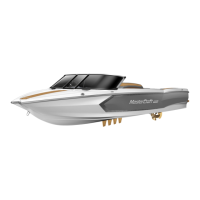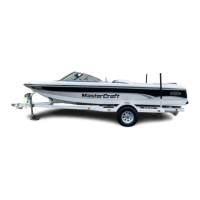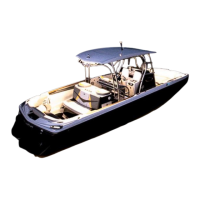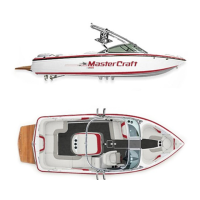CONTROLS AND INDICATORS
7-2
drain on the battery can result in difficulties in re-
starting the boat. It can also cause intermitten erro-
neous or fluctuating gauge readings. To avoid this
situation, when the voltage level reaches 11.5 volts,
the system will shut off the stereo system and sound
the alarm for a period of two minutes to give boat-
ers ample time to adjust.
Other Alarms
Sensors check the oil pressure, engine and trans-
mission temperatures. If the system detects readings
outside the acceptable range, the system shuts off
the stereo (if ON) and sounds the alarm for a period
Although it may be possible to see fuel in the bot-
tom of the fuel tank, you still may not be able to oper-
ate the boat. The fuel pick-up system was designed to
avoid introducing the water and debris that inevita-
bly accumulate in the bottom of the tank. Rather than
relying on visual inspection, you should pay attention
to the fuel gauge.
Temperature Gauge
The temperature gauge indicates
the cooling water temperature in-
side the engine as measured in de-
grees Fahrenheit.
The normal operating tempera-
ture will range from 140 degrees
to 190 degrees. Engines with electronic fuel injection
also have a control circuit inside the engine control
module that will cause the engine to run at reduced
speeds if the module senses that the engine is running
too hot. If you notice that your speed has reduced
during normal operation without reducing the throttle,
monitor your temperature gauge. If the gauge indi-
cates excessive temperatures during operation, slow
down immediately and turn off the ignition. This indi-
cates an engine problem that needs to be checked
by the dealer!
Engine Oil Pressure Gauge
The engine oil pressure gauge
indicates the pressure of the lu-
bricating oil inside the engine. The
average pressure ranges are be-
tween 6 pounds-per-square-inch
(PSI) at 1000 RPM to 40 PSI or
more at cruise-range speeds. A reading of pressure
below 5 PSI at 1000 RPM may be caused by a low oil
level or other potentially serious problems that re-
sult in low oil pressure. If you experience low oil
pressure, stop your engine immediately and check
your oil level before operating again.
Continuing to operate the boat while the temperature is above normal
operating parameters may cause serious damage to your engine. Damage
to your engine resulting from operating the engine in an overheated condi-
tion can be costly to repair. Such damage is not covered by your warranty!
Check Engine Light
The red malfunction indicator
Check Engine light is operated from
an on-board computer that moni-
tors the operation of your fuel, ig-
nition and engine control systems.
On some models, the Check Engine light should come
on when the key is in the ON position and the engine
is not running. This is a check to show you that it is
working. If it does not come on at all, have it repaired
by your MasterCraft dealer right away.
If it stays on–or comes on while you are operating
your boat–the computer is indicating that you have a
problem. You should take your boat to your MasterCraft
dealer for immediate service.
Notice: If you continue to operate your boat
with this light on, you could adversely affect the
emission control systems on the engine. You could
also experience poor fuel economy, and your en-
gine may not run as smoothly. This could lead to
costly repairs not covered by your warranty.
Low Voltage Battery Alarm
In the event that the stereo has been functioning
when the boat is not ON and running, the voltage
Do not continue to run the engine if the oil pressure is low. If you do,
the engine can become so hot that it–or surrounding components–
could catch fire. You or others could be burned and the boat seriously
damaged. Check your oil level and add an appropriate amount of ap-
proved motor oil before operating again or have your boat serviced by
your local MasterCraft dealer. Note that damage to your engine from
englected oil problems can be costly to repair. Such damage is not
covered by your warranty.

